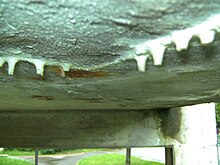Stalactite
A stalactite is a speleothem that hangs from the ceiling of a cave. It is formed as a result of continuous mineral deposits from seeping water, etc.
Calcic stalactites
Every stalactite begins to be created with a simple drop of mineralized water. When the drop falls, it leaves behind it a fine trail of calcite. Each successive droplet that forms and falls deposits another small layer of calcite. Ultimately, these layers form a narrow tube (0.5 mm). These small tubes can grow into a secondary accretionary column or pillar.
In the caves of Nerja (Málaga) are some of the longest known stalactites.
Varieties
There are many varieties, although some of the more common ones receive particular names, such as:
- macaroni, are straight tubes of about millimeters with inner duct. They can reach meters of length and their growth can result in a classic conic stalactite.
- bulbous pineapples or stalactites are formed when a stalactite grows submerged, in part, in water, creating an acretion at the tip.
- deflected stalactites or anemolites are formed, as believed, by air currents that make stalactite not grow straight but with a certain curvature;
- The udders, nabs or beets are not really a variety of stalactites, but possibly the union of a shield with a stalactite.
Stalactites of other minerals
Stalactites are not only formed in natural karstic caverns, they can be formed in any cavity, natural or artificial, that has contributions of mineral-laden water that can precipitate. In this way, we can see small stalactites in old mines, or in volcanic tubes of a certain age, although they are much more modest formations than their equivalents in karstic cavities.
They can be made of materials such as plaster, being in this case known specimens of several meters in length, such as those from the Mexican cave of Lechuguilla. If they are formed from salt, they do not acquire such large sizes due to the crystallization form of this mineral.
Volcanic stalactites
The term stalactite is also used to designate the primary speleothems of volcanic caves that are located on the roof of the cavern. However, since its formation is completely different (lava stalactites are formed by dripping molten lava, in a very short period), the term staphyllite is preferable, typical of the Canary Islands, to refer to these primary stalactites.
Contenido relacionado
Qualibou volcano
Somide
Gulf of mexico







